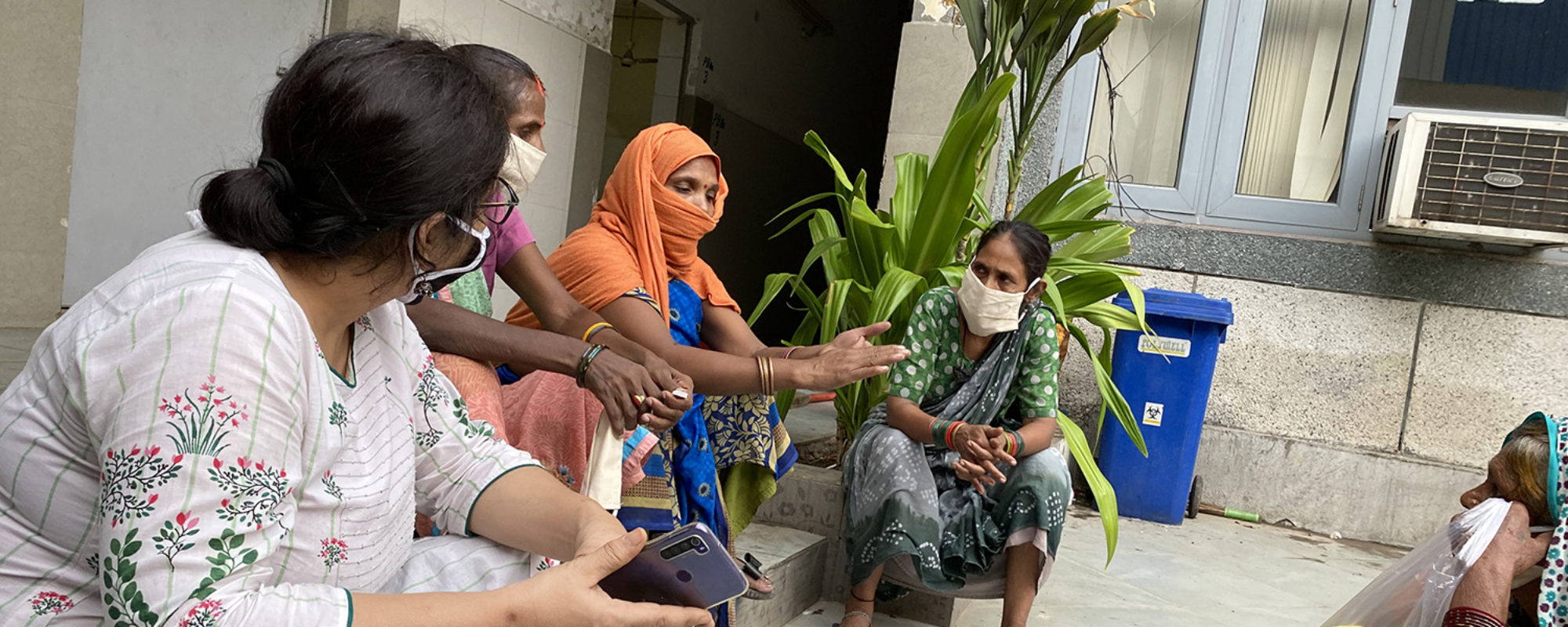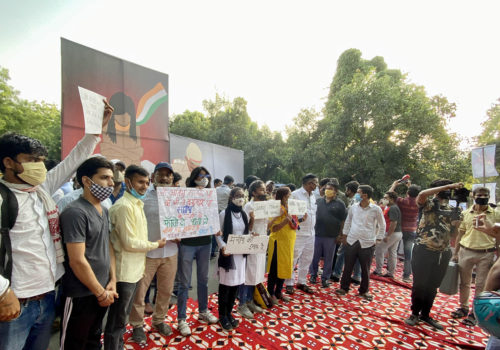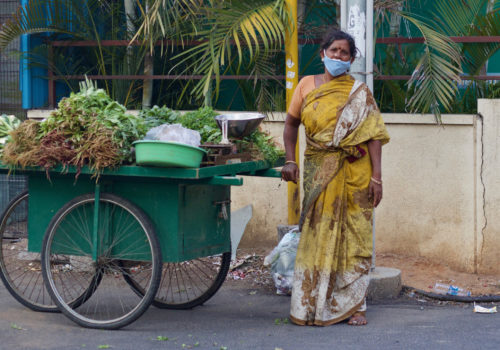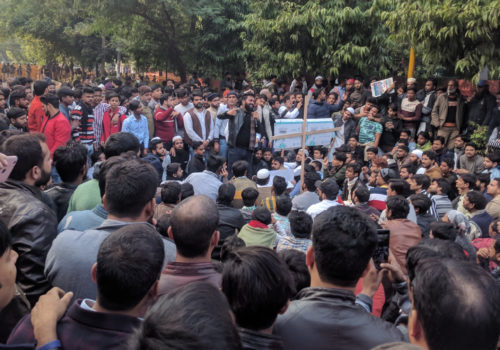Note: This is the first of two dispatches on women’s employment in India.
NEW DELHI — On a Wednesday evening in late July, a group of sari-clad women arrived at an empty campus of an engineering institute in Wazirpur, an industrial area of factories and warehouses in Delhi’s North West district to discuss their rights as workers. Fresh off their shifts on assembly lines or as domestic workers in residential homes, they pulled up their skirts and squatted on the muddy ground of a long green courtyard, chatting among themselves as mosquitoes swarmed them.
A young volunteer passed a tray of small paper cups filled to the brim with milky tea. Leading the discussion was a woman named Lokesh, who pulled out her notebook as the women eagerly counted cups to ensure everyone had her share. Then she began: “Last week, I asked you all to write down on a piece of paper exactly what kind of work you do, and how much you get paid for it. Did you bring this information with you?”
The women shrugged, some shaking their heads sheepishly. Undeterred, Lokesh continued: “Very well, we’ll write this information down together. As I told you last time, it’s important to know your rates so you can compare and contrast for more bargaining power.”
Such was the routine every Wednesday during meetings of an initiative called the Workers’ Dhaba—much to the dismay of the women’s bosses and husbands, who sometimes forbid them from attending. Here, they learned about ways to navigate the financial turmoil caused by the coronavirus pandemic.
A key perk was free food, which few turned away at a time when feeding one’s family had suddenly become a luxury.
Millions of people in South Asia have been tipped into poverty because of the recession caused by the pandemic, a recent report by the World Bank estimated. India’s GDP shrank by 24 percent in the last quarter, the biggest drop in 24 years. This economic contraction will have a significant impact, disproportionately affecting informal workers. Women and girls are even more vulnerable due to their overall lower participation rate in the labor market. Back in March, when India enforced one of the world’s strictest lockdowns, more than 120 million workers lost their jobs overnight. The majority were informal laborers forced to make long and often grueling journeys from cities back to their villages. In Wazirpur, thousands of workers remained, lacking the means to leave (or even homes to which to return).
Amid this shock, women have taken a particularly heavy hit. Accounting for merely 21 percent of the labor workforce—one of the lowest rates in the world even before the pandemic—an Action Aid survey in June found that 79 percent of women were out of work after the lockdown. Ninety-five percent of women work in the informal sector, and those still employed receive very little support from their families or the state. “What we are seeing is that it’s the woman whose needs are the first to be put on the back burner,” said Shalini Sinha, of the nonprofit Women in Informal Employment: Globalizing and Organizing.
Sinha says women in the informal sector face three key impediments: a loss of jobs, but an increase in total working hours because of the care they typically provide at home; a lack of agency to choose the kind of work they want to do; and ongoing stigma from the perception that they have poor hygiene or are prone to carrying the coronavirus. As a result, “their days have become very long and tiring.”
Women are also less likely to join unions or advocacy organizations, meaning they’re left out of decision-making and therefore tend to be more vulnerable. Those involved in domestic work have no way of ensuring protection from their employers who are less likely to wear masks in their own homes, and who are less compelled to inform their workers if they are sick. Being laid off or unable to collect pay is the new norm for many, Sinha added. Workers have been forced to find jobs wherever possible, with some selling fruit on the streets and others reduced to begging, unable to find any alternatives. “The story is very grim,” she said.
Women in the informal sector face a loss of jobs, lack of ability to choose the kind of work they want and stigma from the perception they have poor hygiene or are prone to carrying the coronavirus.
Government support has also varied from sector to sector—the result of thinking about the informal economy as “a monolith,” says Paromita Sen, a researcher who wrote a report on gender disparities brought on by the lockdown. In reality, a wide variety of trade and occupations, from agriculture to domestic work, require vastly different responses. “Trying to figure out how to redirect sources for different workers is a challenge,” she said. Federal, state and village-level responses have all been mixed.
Some village councils have taken charge themselves, directing local self-help groups to make sure everyone is fed. Individual women have helped, too: The Self Employed Women’s Association (SEWA) Bharat, which runs various development programs, has a unique network of grassroots leaders called “agevans” who monitor government outreach efforts, such as cash transfers to those in need. It has also sponsored social enterprises run for and by disadvantaged women to help them financially recover. Still, government welfare programs require documentation—which excludes many informal workers who migrate to cities.
* * *
Between March and July, the Workers’ Dhaba stepped in to provide food and various forms of aid to support those who fell through the cracks of the official welfare system. The initiative was led by the Center for Education and Communication (CEC) and Citizen Collective for Humanitarian Relief, two nongovernmental organizations.
At the session in late July, Lokesh, the executive director of CEC, patiently took notes as women went around the circle announcing their names, occupations and salaries. That was no easy feat: It’s rare for women to earn an independent salary, and rarer still to openly discuss the financial affairs of their households. That could potentially lead to resentment, jealousy or, worse, competition.
But with most women having seen a significant drop in their earnings, these experiences were cathartic. Occasionally, discussions strayed as participants joked and teased one another. If a latecomer arrived, they would break into welcoming applause. That is common in many parts of the country, says Sen, the researcher on gender disparity, and in the absence of any formal support, these women have configured “their own parallel systems rooted in empathy and community and supporting one another.”
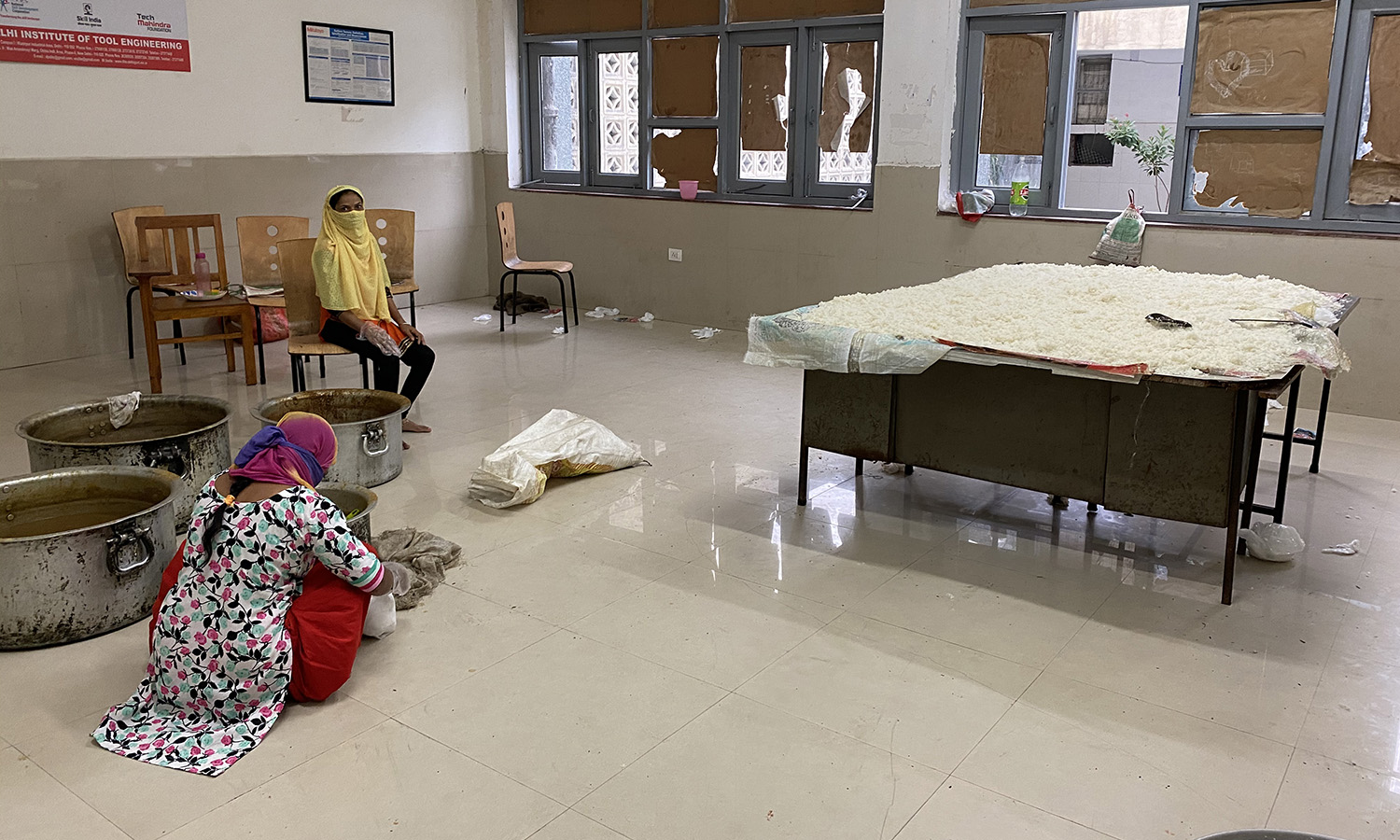
When Pinky, a domestic worker, referred to herself as a “mai,” or maid, Lokesh was quick to correct her: “We call them gharelu kamgar (domestic workers).” The same applied to factory workers, she said, who were prone to describing their tasks rather than their occupation (“I work with chalk,” or “I polish things”). “You are called factory workers,” she emphasized. “What kind? Repeat after me: Fac-to-ry workers.”
Members of the latter group said they earned around 5,000 ($68) per month on average. Their tasks ranged from fitting electric and household goods to packing utensils, nuts and bolts, polishing metals and manufacturing chalk dust. Some worked directly for factory owners, while others got their wages from contractors who employed them on a project basis. The domestic workers, meanwhile, earned around 2,500 ($34) rupees per day in a four-person household, where their tasks included cleaning, washing the dishes and cooking. They worked in two to three households daily.
Pinky, who was employed by four families before the pandemic, earned around 10,000 rupees ($136) per month, a respectable amount to help pay for her kids’ school fees, rent and household expenses. But in April, as the crisis began taking its economic toll, she was told not to return to two of those households. Usha, who worked in three homes, wasn’t technically laid off from any of those jobs—nor did she get paid for the three months, while the government’s lockdown restrictions meant she couldn’t go to work.
Upon hearing about Pinky’s and Usha’s experiences losing jobs or payment, Lokesh hammered home the importance of contracts. “If your boss has not given you any paperwork, that means there’s nothing we can do if they stop paying you.” Meanwhile, only one of the women at the Workers’ Dhaba carried a state-issued insurance card affording her some financial protection through medical coverage and various cash benefits. Many others had no form of identification at all.
By this point, the sun was fading and the street lights began to flicker on. Many women seemed distracted, perhaps by expectations of returning home to provide their families with dinner. Lokesh sensed their agitation and cut the discussion short: “We’ll continue next week. Now, it’s time for food.”
In August, the Workers Dhaba halted its workshops due to a lack of funding. While the economy is slowly resuming after the government lifted most lockdown restrictions, many informal workers, like the women in Wazirpur, continue scrambling for their daily wages—cleaning homes, polishing metal and packing chalk in factories for more hours and less pay.

